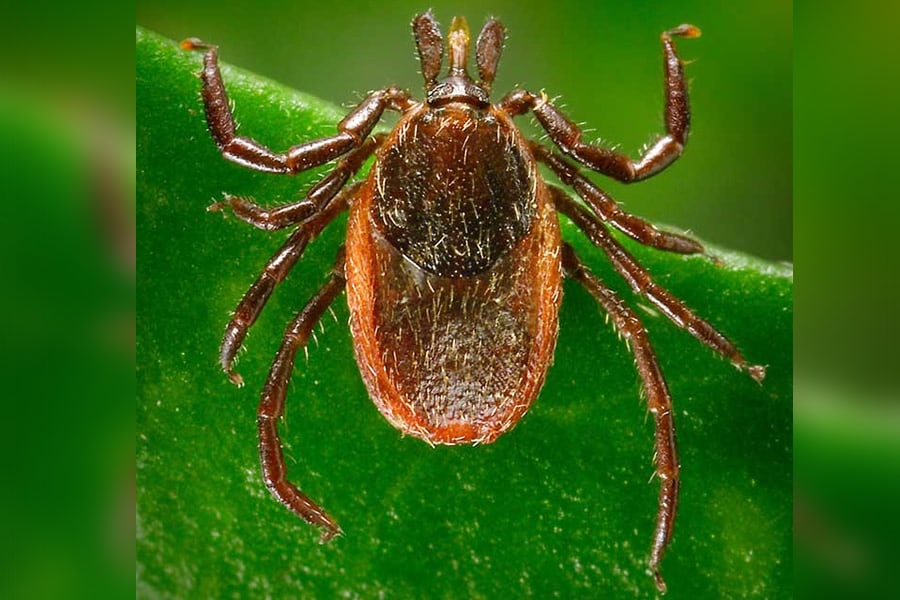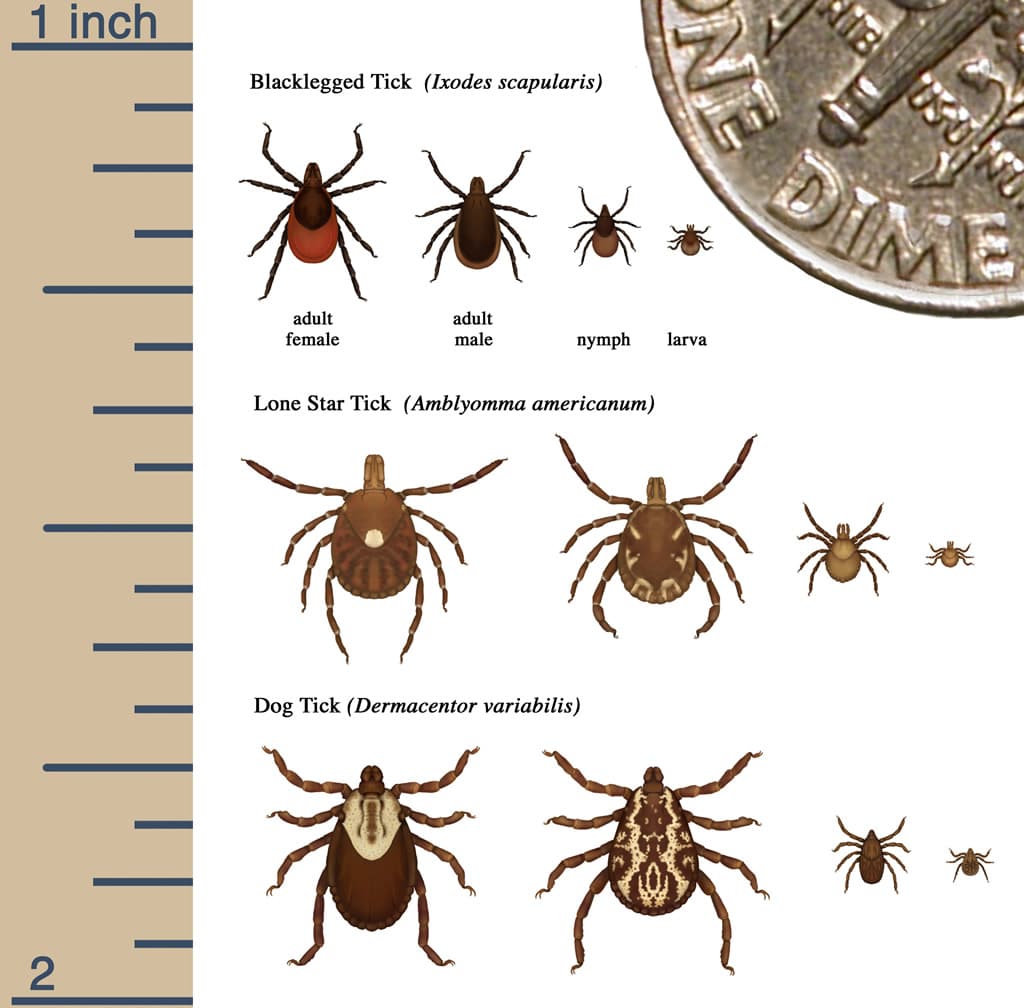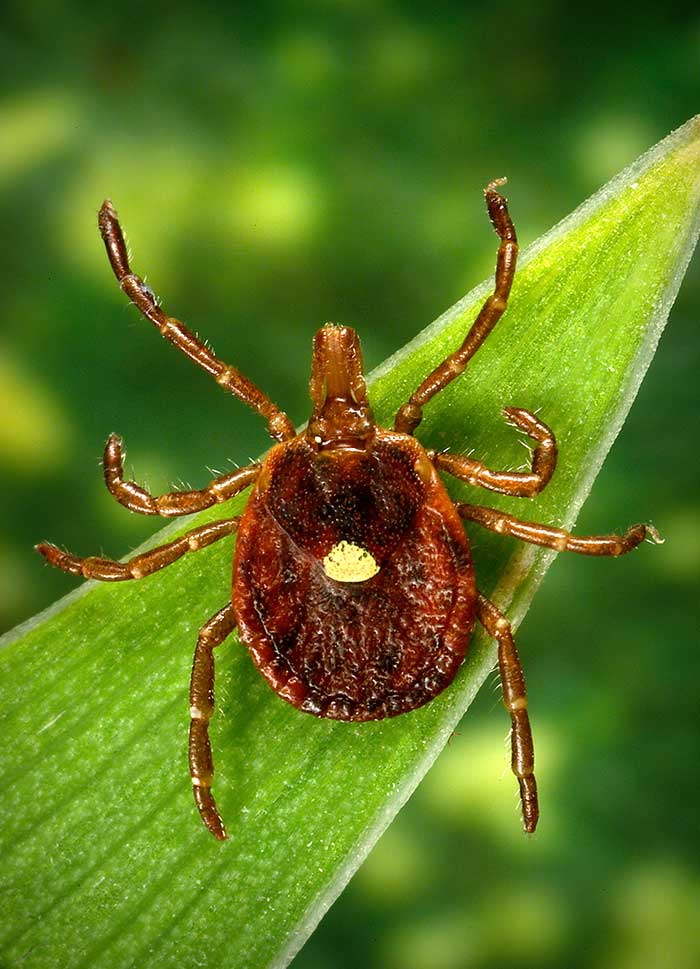
Article Summary
- Black-legged ticks, also called deer ticks or Ixodes scapularis are the ticks primarily responsible for infecting humans with the bacteria that can cause Lyme disease.1
- There are several other types of ticks such as the American dog tick (wood tick), the Lone Star tick, and others that don’t cause Lyme Disease but can can transmit harmful bacteria which can lead to other types of infections
- Most cases of Lyme disease occur in the upper midwest and the northeastern portion of the U.S. but cases are rising everywhere.2
- Lyme disease is often caused by tiny tick nymphs that often go undetected and remain attached long enough to transmit the Lyme disease bacteria.3
- The transfer of bacteria from ticks to humans, is what causes Lyme disease
What Ticks Carry Lyme Disease
In the US, it is the black-legged tick variety that carries the bacterium that causes Lyme disease. There are 2 varieties of this tick, based on where they are found:
- The Black-legged Deer Tick (Ixodes scapularis) is most commonly found in the upper midwestern and northeastern United States. According to the Centers for Disease Control (CDC), 95% of Lyme disease cases were reported in 14 midwestern and northeastern states.2
- The Western Black-legged Tick (Ixodes pacificus) occupies the pacific region including California, Oregon, and Washington. Only about five percent of Lyme disease cases occur in this region.3
Common wood ticks and the lone star tick are not commonly believed to carry the bacterium that can lead to Lyme Disease.
What Do Black-Legged Ticks Look Like?
Adult female black-legged ticks have reddish-brown bodies, while the males are slightly smaller and have all brown bodies. Younger tick nymphs are brown and tan, while the larvae are more translucent and tan.
The front legs of a black-legged tick are more forward-facing, while the front legs of wood ticks and lone star ticks fan out more straight and to the sides.
Black-legged ticks are about half the size of wood ticks and lone star ticks which do not carry Lyme disease-causing bacteria.
Here is a great picture from the CDC to compare sizes and markings of each stage and species.
What is the Size of Black Legged Ticks?
Black-legged ticks range in size during their life cycle from the size of a poppy seed to the size of a sesame seed. Imagine looking in a poppy-seed muffin and trying to distinguish a nymph tick from a poppy seed. They’re that small.
Contact LifeWorks
727-466-6789
727-451-1010
Friday: 9:00am – 4pm
Clearwater, FL 33756
Become A Patient
"*" indicates required fields
Do All Black-Legged Ticks Carry Lyme Disease?
According to the Minnesota Department of Health, one in three adult black-legged ticks is infected with the Lyme disease bacteria while about one in five nymphs carry the bacteria.4
Another study published on PLUS ONE5 in the northeast and upper midwest regions, showed that up to 50 percent of deer ticks carried the Lyme disease-causing bacteria. In contrast, in the southern and western regions, less than 10 percent were infected.
In addition, the bacteria that causes Lyme disease is not transferred from the adult female to her eggs, so tick larvae are hatched without it. They acquire it from feeding on a host. Once a tick is infected it can transfer the bacteria to each new host throughout its lifetime.
How Do Ticks Attach to Their Hosts?
Since ticks can’t jump or fly, they wait on the tips of greenery such as leaves, shrubs, and grasses waiting for a host to brush up against their resting place. This is known as “questing”. While questing the tick stretches out their upper pair of legs and holds onto the greenery with their lower legs. When someone happens by, the tick climbs onto the host.
Next, the tick searches for a place to bite the host. This is easier to do on animals or on people with exposed skin areas. When it finds a suitable place to feed, the tick grabs the skin and cuts into it. It then inserts its barbed feeding tube into the cut. In order to stay attached the tick secretes a bonding substance.
Interestingly, ticks may secrete saliva with a bit of anesthesia-producing properties so that the host can’t feel it. In addition, part of the secretion has anti-coagulating properties so that the blood will not coagulate (thicken and clot). A tick usually feeds for several days and then drops off of the animal or human to find a new host.
Behavior of Black-Legged Ticks
Ticks need to feed on the blood of a human or animal in order to survive. This helps them grow and move into each new stage from larva to nymph to adult. An adult female tick becomes quite engorged with blood in order to produce thousands of eggs to lay. Interestingly only a small percentage of these eggs will survive. The black-legged tick has a two-year life cycle and the larvae’s first meal is usually a small animal like a rodent. Next, they move on to larger animals and humans.
A tick only inserts its mouthparts into its host. A common myth is that it inserts its whole head, but this is not true. This mouthpart is also used by the adult male to fertilize the female eggs.
Black-legged tick larvae and nymphs are most active in late spring and early summer. Adults are most active in late summer through fall, and then again early the next spring. They are much more active in temperatures above 45 degrees Fahrenheit and thrive in humid climates.
How is Lyme Disease Transmitted?
There are two main types of bacteria that cause Lyme disease in the United States: Borrelia burgdorferi and Borrelia mayonii. Lyme disease is transmitted through the bite of a tick infected with this bacterium.
Also, the tick usually needs to be attached 36 to 48 hours or more before the Lyme disease bacterium can be transmitted.
Humans are commonly infected through the bites of immature ticks called nymphs. Nymphs are tiny (less than 2 mm) and difficult to see; they feed during the spring and summer months. Adult ticks can also transmit Lyme disease bacteria, but they are much larger and are more likely to be discovered and removed before they have had time to transmit the bacteria.
This is why the immature form of ticks called nymphs are usually the culprit for transferring Lyme disease bacteria. They are so much smaller that people don’t notice them until they have been attached for a longer amount of time. Consider that the size of an adult tick is approximately the same as a sesame seed, while the nymph is more like a poppy seed.
Ticks can attach to any part of the body, but they are particularly common on the scalp, in the armpits, and in the groin. Deer ticks in the nymph stage would be especially difficult to find in these areas. The longer a tick feeds, the more and more engorged it becomes.
Symptoms of Lyme Disease
Here are the common symptoms of Lyme disease:
- A Bullseye Rash – This is not always present and many people without a rash test positive for Lyme disease.
- Headaches – This is one of the most commonly reported symptoms of Lyme disease.
- Flu-like Symptoms – These Include fever, body aches, fatigue, chills, and of course headaches. About 25% of people have flu-like symptoms and may not associate them with a bite.
- Joint Pain – This includes weakness, swelling, arthritis, and severe joint pain.
- Neurological Problems – Untreated Lyme disease can cause inflammation of the membranes surrounding the brain. This is called meningitis and may cause temporary paralysis, weakness, shooting pains, tingling, and burning in different parts of the body.
- Unusual or Unexplained Symptoms – These may include a range of symptoms such as diarrhea not related to the flu, abdominal pain, nausea, headaches, anxiety, fatigue, general malaise, brain fog, neck stiffness, swollen glands, and difficulty sleeping.
Who Is at Risk for Lyme Disease?
Those most at risk for contracting Lyme disease include those who work or spend time outdoors in the areas where black-legged ticks are most prevalent. This is especially true for those who work or hike in areas with grasses, brush and trees. Another factor that increases risk is having pets in the home as they can bring ticks in which drop off when they finish feeding and crawl onto a human host.
According to the Environmental Protection Agency (EPA), the rates of Lyme disease in the United States has almost doubled since 1991.6 This study points out that among the 14 states where Lyme disease is most common, these states have seen the largest increase since 1991: Maine, New Hampshire, Vermont, Delaware, and Massachusetts.
How to Protect Yourself from Black-Legged Ticks
Here are some tips to protect yourself from black-legged ticks:
- Wear light-colored clothing that covers your arms and legs such as long-sleeve shirts and pants when working and enjoying the outdoors. This way the tick has to work harder to reach your skin, and it will be easier to see on the clothing.
- Apply natural tick repellent to your clothing, especially on the arms and legs.
- Wear a hat and put long hair up and under the hat.
- Place a rubber band around your pants at the ankle area or where they meet your shoes or boots, or tuck them into your boots
- Upon returning indoors, carefully check your clothing and body for ticks. It is helpful to have someone else inspect your body as well. Adults should carefully inspect children when they come in from hiking or play in wooded or grassy areas.
- Wash your clothes immediately rather than putting them in a hamper or on the floor. The ticks can crawl off the clothes and climb onto a human or pet.
- Inspect pets carefully after venturing into wooded or brush-filled areas.
If you find a tick you should remove it by grasping the head, not the body, with tweezers and slowly pulling backward. If you grasp the body you may squeeze the fluids from the tick into your skin, further increasing the chance of infection. In addition, removing the tick slowly will cause it to pull its mouthparts out of your skin.
Once the tick is removed, clean the area with soap and water and apply rubbing alcohol or an antibiotic ointment. Save the tick in case it needs to be tested.7
Natural Treatment of Lyme Disease
Many people go undiagnosed (or misdiagnosed) because all the most common Lyme tests are not sensitive enough to detect late stage Lyme Disease.
We have an extremely sensitive Lyme disease test that detects Lyme positively and routinely confirms Lyme when other tests come back negative.
If you discover you’ve been bitten by a tick very recently, the standard course of treatment is antibiotics. This can be effective if antibiotics are delivered soon after a bite.
However if the bite was undetected (which is common) and months or years later you test positive for Lyme Disease, antibiotics are usually not effective.
In such cases a more comprehensive program is commonly needed to clear the active infection, heal the damage caused by a long-term chronic infection, eliminate Lyme co-infections and fix the original factors that contributed to a weakened immune system that left you predisposed to a Lyme infection in the first place.
Contact Us
For the last 23 years we’ve developed an all-natural, powerful regimen that clears Lyme infections and restores your health to a level that you might not have experienced in years or decades.
Dr. Minkoff is a world-renowned infectious disease doctor and Lyme disease expert and has helped hundreds of patients successfully recover from the disease.
To discuss your symptoms or to schedule an appointment, call us at our Clearwater clinic at 727-466-6789 or submit an online patient inquiry.
For more information on the symptoms and treatment of Lyme disease including our natural treatment protocols, visit our Lyme Disease Treatment Section.
More Information on Ticks
Ticks that Transmit Illnesses Other Than Lyme Disease
Lone Star Ticks
The lone star tick has a much shorter, rounder shell, and the adult female has a distinct yellowish marking in the middle of her shell.
Lone star ticks transmit bacteria that cause
- human ehrlichiosis
- Tularemia
- Heartland virus disease
- Bourbon virus disease
- Southern tick-associated rash illness (STARI).
There is also an association between those who have been bitten by lone star ticks and allergic reactions to eating red meat.
Human ehrlichiosis can cause fever, chills, a severe headache, intestinal issues, mental confusion and sometimes a rash. Untreated ehrlichiosis can cause damage to the central nervous system (CNS) and the brain, lung failure, organ failure, bleeding issues, and death.8
Heartland virus disease can be life-threatening and almost all patients with the disease have needed hospitalization. Symptoms may include fever, loss of appetite, intestinal issues, muscle pain, joint pain, low white blood cell counts and increased liver enzymes.9
Bourbon virus disease is much more rare and has only been identified in the Midwest and southern U.S. Symptoms follow the other non-life-threatening illnesses caused by ticks, plus low white blood cell counts.10
Tularemia is a disease that is not only transmitted through ticks, but also by deer flies, skin-to-skin contact with infected animals, lab exposure, drinking contaminated water, and inhaling contaminated particles. It can cause the death of large numbers of rabbits, hares, and rodents when outbreaks occur.11 Symptoms of tularemia transmitted by ticks can include:
- Ulceroglandular tularemia – A skin ulcer accompanied by swelling of the lymph glands typically in the groin or armpit glands
- Glandular tularemia – Swelling of the lymph glands without the ulcer
Other reactions caused by tularemia that is transmitted in the other ways mentioned may affect the eyes, chest and lungs, and the pharynx.
The bacteria that causes Southern tick-associated rash illness (STARI) is not known, however the symptoms resemble Lyme disease and it is often treated in a similar manner. Symptoms include a bulls-eye rash, fatigue, headache, muscle aches, and fever.12
Dog Ticks (Wood ticks)
Dog ticks (wood ticks) have lines and spots on their brown and reddish-brown bodies in beige colors. These look almost like the markings on a shield. They also have a wider shell than deer ticks. Dog ticks transmit bacteria that cause
- Rocky Mountain spotted fever (RMSF)
- Colorado tick fever
- Tularemia
Rocky Mountain spotted fever causes a high fever, malaise, myalgia, severe headache, swelling around the eyes and in the hands, and intestinal problems. If not treated it can cause mental issues, a coma, cerebral edema (brain swelling), respiratory issues, necrosis (the death of body tissue that must be amputated), and organ failure. RMSF is a life threatening disease if not treated properly and early.13
Colorado tick fever causes fever, body aches, chills, headache, and fatigue, but can also cause intestinal issues, rashes, and a sore throat. It may be hard to distinguish between this and a cold or flu virus. Most people recover fully from Colorado tick fever, however in some cases the fatigue and weakness last for several weeks. There have also been rare cases that cause a stiff neck and mental confusion.14
References
- Centers for Disease Control, Diseases Transmitted by Ticks, April 2020.
- Centers for Disease Control, Lyme Disease, September 2019.
- Centers for Disease Control, Transmission, January 2020.
- Minnesota Department of Health, Ticks, August 2019.
- PLOS ONE, Using citizen science to describe prevalence and distribution of tick bit and exposure to tick-borne diseases in the United States, Nathan C. Nieto et. al., July 2018.
- Environmental Protection Agency, Climate Change Indicators in the United States: Lyme Disease, August 2016.
- Terminix, Black-Legged Ticks (A.K.A. Deer Ticks), 2020.
- Centers for Disease Control, Ehrlichiosis Signs & Symptoms, January 2019.
- Centers for Disease Control, Colorado Tick Fever Symptoms & Treatment, December 2018.
- Centers for Disease Control, Heartland Virus Symptoms & Treatment, October 2018.
- Centers for Disease Control, Bourbon virus, January 2019.
- Centers for Disease Control, Tularemia, December 2018.
- Centers for Disease Control, STARI Signs & Symptoms, November 2018.
- Centers for Disease Control, Rocky Mountain Spotted Fever (RMSF), May 2019.






